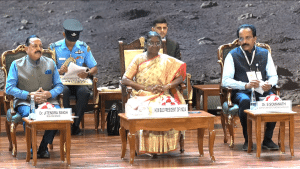Infrastructure development is an uphill task involving multiple stages & stakeholders. Tech solutions are making it smoother, faster, and smarter.
“America’s roads are good not because America is rich. America is rich because of its good roads” John F. Kennedy.
Indian construction market is set to become the third largest in the world by 2030, contributing 15% of the country’s GDP and employing more than 70 million people, as per a KPMG report.
Delhi-Mumbai Corridor, National Infrastructure Pipeline, BharatMala Pariyojana, and the PM Gati Shakti Master Plan are some of the ongoing flagship government infra projects aimed at massive connectivity.
From conception to completion stage, the rapidly growing AEC sector involves collaboration between architects, engineers, construction managers, contractors, urban planners, and various other specialists. The multi-stakeholder participation and inter-disciplinary approach make mega AEC projects extremely complex and at times tedious tasks.
Unsurprisingly, in a recent interview with a leading national daily, the outgoing L&T (Larsen & Toubro) Chairman, AK Naik, called ‘Infrastructure building the most difficult job in the world’.
Geospatial visualizations, 3D models, data aggregation, and the use of BIM, aim to make things somewhat easier, simpler, faster, and efficient in the sector whose perception is of a lumbering giant, immune to new changes.
Going with the times and staying ahead of market competition, the AEC industry has been increasingly adopting technological advancements like Building Information Modelling (BIM), virtual reality, and sustainable design practices to enhance efficiency, communication, and sustainability in project development.
Tech Averse?
Just like risk-aversion is a basic human behavioural instinct, and a determinant in most economic decision- making, AEC has traditionally been identified as a tech-averse sector. Though now, things are changing radically due to the pervasive reach and extent of technology integration across processes and workflows.
Building Information Modelling (BIM), Computer Aided Designs (CAD), drones, virtual reality, 3D printing, LiDAR, GIS, and Digital Twin are some technologies that are being integrated into various stages of planning, design, construction, and management processes.
These technologies help improve collaboration, streamline workflows, enhance project visualization, and optimize resource utilization.
“We need to adopt technology at a much faster pace, and we do not have much time,” said Sunil MK, Sales Head, Autodesk.
However, like any industry, there might be some resistance or challenges in implementing new technologies due to factors such as cost, training, and adapting to new processes.
On the issue of cost, Rajan Aiyer, MD, Trimble India says “Resistance will also be in the form of whether Capex should be spent on these technologies (as an after-thought) which is wrongly believed to affect margins negatively. The truth is that the TCO is greatly reduced by using these technologies, the customer can bid more intelligently using the data from projects, and finish projects with higher quality and ESG, in shorter time and with greater safety.”

AEC Workflows
The AEC industry has a stepwise workflow that is largely followed by organisations across. The fourstep flow guarantees smooth operations, minimizes errors, and helps in identifying barriers.
However, due to irregular workflows, non-uniform softwares, multiple divisions, and lacking interoperability makes the projects inefficient and costly.
“Life in the construction world is very tough. Often the entire process is disconnected, and here we use the word – dark data – which is disconnected across the lifecycle, so the stakeholders really don’t know what they have, creates huge challenges,” says Kaushik Chakraborty, Senior Vice President, Asia Pacific Bentley Systems.
Planning
Planning before building something is a prerequisite for workflows to streamline the process, enhance accuracy, and ensure successful project outcomes. A host of technologies are used to make the planning phase more efficient and precise.
Some important technologies are:
Geographic Information Systems (GIS): A widely adopted technology in the AEC industry, GIS helps analyse and visualize geographic data, aid in site selection, land-use planning, and assess environmental factors that impact the project.
It also helps planners understand zoning regulations and ensure compliance with local codes and regulations during project planning.
One such project displayed the potential of GIS technology. The Mumbai-Nagpur Expressway project integrated GIS for aided route selection, environmental impact assessment, land acquisition planning, optimizing project alignment and reducing potential conflicts.
Dr. Surendra Ahirwal, Joint Secretary, Logistics & Trade, Ministry of Commerce & Industry, GoI, explained the need for dynamic and constantly updating data while talking about the PM Gatishakti National Master Plan. “While GIS typically pertains to unchanging physical structures, it’s vital to consider the dynamic elements associated with each fixed asset. For instance, a building’s nomenclature can shift over time. Hence, we are dedicated to seamlessly integrating dynamic data to its fullest extent.”
“This reservoir of dynamic data facilitates a comprehensive market assessment that spans historical, current, and future perspectives. Armed with this valuable insight, we can construct diverse scenarios and accordingly devise strategic infrastructure plans,” he adds.
Talking about the interoperability of GIS with Digital Twin, Agendra Kumar, Managing Director, Esri India says “GIS-based Dgital Twins have geo-referenced features that make them powerful tools for analyzing, visualizing, and simulating geospatial data and phenomena, enabling better understanding and decision- making in various domains such as urban planning, infrastructure management, environmental analysis, and emergency response.”
Aerial Imaging and Remote Sensing: Aerial Imaging through drone LiDAR assists in site assessment, surveying, and obtaining accurate site information. Aerial Imaging and Remote Sensing stand as pivotal technologies in the AEC industry, offering a bird’s-eye view that transcends traditional limitations.
By harnessing data and imagery captured from airborne platforms such as drones, satellites, and aircraft, these technologies revolutionize project planning, design, and oversight. The prowess of Aerial Imaging lies in its ability to provide a comprehensive visual assessment of construction sites, delivering precise topographic maps and 3D models that lay the foundation for informed decision-making.

This technology becomes a powerful communicator by portraying the envisioned project within its environmental context, revealing its implications and compatibility with the surrounding landscape. On the other hand, Remote Sensing takes the spotlight in environmental impact evaluations, identifying ecological factors, and playing a critical role in sustainability strategies.
As construction progresses, both Aerial Imaging and Remote Sensing maintain their significance, offering regular progress updates, monitoring safety compliance, and aiding in quality control.
Earth Observation: Satellite mapping and Earth observation have emerged as integral tools within the AEC sector, revolutionizing how projects are planned, executed, and managed.
Satellite imagery provides a comprehensive and up-to-date view of construction sites, enabling professionals to gather accurate topographic data, assess terrain conditions, and visualize the surrounding environment.
Earth observation satellites equipped with high-resolution cameras and sensors capture detailed images that aid in site selection, infrastructure design, and urban planning. These images offer insights into land use, vegetation cover, water bodies, and potential environmental challenges.
Additionally, the data obtained from satellite mapping supports project monitoring by providing regular updates on construction progress. This facilitates informed decision-making, helps identify potential delays, and contributes to effective resource allocation.
Satellite technology’s non-invasive nature and wide coverage make it an invaluable tool for tracking large-scale projects, ensuring compliance with design specifications, and mitigating risks associated with construction in challenging terrains or environmentally sensitive areas.
“The data received from satellites and other sources are heavy and difficult to compute. The insights from AI and analytics makes it easy to use, compute, distribute and generate insights from these sources. AI will take to the next level by augmenting human effort in deciphering this data for real world usage,” explains Saurabh Rai, CEO, Arahas Technologies.
Sonali Dhopte, Director, Excelize emphasised on location- based data, “Spatial location- based data is already a reality, and we are using this extensively today. I believe that using AI based generative design will transform the infrastructure development. Optimizing design, cost, execution and providing multiple solutions that are quick to develop, cause minimal environmental impact will be the norm in the near future. Predictive analytics will identify challenges early and help avoid cost and time over runs in infrastructure development.”
LiDAR: Terrestrial and LiDAR laser scanning captures precise measurements and 3D data of existing structures and sites, facilitating accurate as-built documentation. LiDAR, an acronym for Light Detection and Ranging, stands as a transformative technology within the AEC sector.
By harnessing laser light pulses, LiDAR captures intricate three-dimensional representations of physical environments with extraordinary precision. In the realm of AEC, this technology proves invaluable across a spectrum of applications.
It empowers professionals with accurate topographic mapping, furnishing detailed elevation data that informs site analysis, land surveying, and infrastructure design. LiDAR’s prowess extends to construction monitoring, where it facilitates real-time progress assessments by creating comprehensive point clouds of evolving construction sites.
When integrated into BIM workflows, LiDAR enriches the accuracy of as-built models and streamlines clash detection during the project’s lifecycle. The technology transcends construction boundaries, aiding in historical preservation, flood management, urban planning, and environmental assessment.
As it continues to redefine possibilities, LiDAR emerges as a beacon of precision, elevating the AEC industry’s approach to design, planning, and execution through data-driven insights.
LiDAR technology facilitated the creation of detailed topographic maps and accurate terrain models in Gujarat, aiding in the planning and execution of the foundation and surrounding infrastructure during the construction of the world’s tallest statue, the Statue of Unity.

Trimble’s structural engineering software Tekla Structures helped complete the construction of the statue a full two months ahead of schedule and with a 25 percent efficiency gain.
Another use-case of LiDAR technology was witnessed in the Kolkata Metro project for accurate surveying and mapping of tunnel alignments and underground structures which ensured minimal impact on existing infrastructure, resulting in smooth project execution.
Virtual Reality (VR) and Augmented Reality (AR): During the designing process, AR and VR provide virtual experiences and walkthroughs of proposed designs and structures for stakeholders.
VR and AR have revolutionized the AEC industry by introducing immersive and interactive experiences that enhance design visualization, communication, and project collaboration. VR creates computer-generated environments that users can experience through specialized headsets, while AR overlays digital information onto the real world through devices like smartphones or glasses.
In the AEC sector, VR is employed to offer clients and stakeholders immersive walkthroughs of proposed designs before construction even begins. This technology enables architects and designers to showcase concepts in a realistic context, aiding in design validation and eliciting valuable feedback.
It also aids in identifying potential design flaws early in the process, saving time and resources. AR, on the other hand, supplements the real world with digital data, making it an asset during on-site construction.
AR applications allow workers to visualize building components, systems, and utilities in their physical environment, facilitating accurate installation and reducing errors.
Designing
In the designing phase of the AEC industry, a variety of advanced technologies are harnessed to translate concepts into detailed and efficient designs. These technologies enhance creativity, collaboration, and precision throughout the design process.
Some important technologies used in designing include:
Computer-Aided Design (CAD): Computer-Aided Design (CAD) revolutionized the way professionals conceptualize, communicate, and realize designs.
Through CAD software, architects, engineers, and designers create intricate 2D and 3D models, translating their creative visions into precise digital forms. These models serve as a canvas for visualization, empowering stakeholders to grasp the intricacies of a project before it materializes.
CAD’s interoperability allows teams to simultaneously shape designs, regardless of geographical boundaries, fostering seamless teamwork and minimizing errors. Its power to swiftly adapt and refine designs offers flexibility, enabling modifications without the arduous task of starting from scratch.
Its indispensable role in generating comprehensive documentation, complete with dimensions, annotations, and specifics, supports construction teams in translating visions into reality with accuracy.
Furthermore, its ability to identify clashes within designs and facilitate material quantification empowers budgeting, procurement, and regulatory compliance. In the AEC realm, CAD’s integration with advanced tools for structural analysis, energy assessment, and sustainable practices elevates projects, culminating in enhanced efficiency, precision, and successful outcomes.

3D Modelling & Building Information Modelling (BIM): The two essential technologies transforming the AEC sector, 3D modelling and BIM enables collaboration between various disciplines, enhances project visualization, and helps detect clashes and conflicts before construction begins.
3D modelling allows professionals to create realistic three-dimensional representations of structures, offering a visual preview of designs with accuracy and detail.
“The biggest innovation in AECO (Operations) in 21st century is ability to do 3D modelling to 3D printing and everything in between,” emphasised Saurabh.
BIM, on the other hand, takes this concept to a higher level by creating a digital database that holds comprehensive project information, including design details, materials, systems, and schedules. It’s a collaborative platform that ensures all stakeholders work with the same accurate data, reducing errors and clashes.
BIM is not just about design; it covers the entire lifecycle of a project, aiding in construction, maintenance, and operations. Together, 3D modelling and BIM enhance communication, improve efficiency, and streamline processes in the AEC industry.
“BIM technology revolutionized project design and collaboration by creating 3D digital models that incorporate geometry, data, and other information. This streamlines communication among stakeholders and enhances project coordination. Now, BIM is evolving from 3D modelling to encompass 4D (time scheduling) and 5D (cost estimation) capabilities, enabling further accuracy in project planning, scheduling, and cost management,” an industry expert tells.
The Kempegowda International Airport Expansion employed 3D laser scanning and BIM to capture accurate information and plan terminal expansions. This technology facilitated seamless integration of new structures with existing facilities and minimized disruptions to airport operations.
The Mumbai Coastal Road Project also deployed 3D visualization tools to create realistic representations of the proposed road along the coastline which allowed stakeholders to visualize the project’s impact on the environment and infrastructure, facilitating informed decision-making and public engagement.
Virtual Reality & Augmented Reality: VR & AR technologies provide immersive experiences that allow designers and clients to interact with virtual prototypes, aiding in design & communication.
Both VR and AR foster better collaboration among project teams by enabling stakeholders to interact with the design and construction process in an intuitive and engaging manner.
These technologies enhance communication and comprehension among multidisciplinary teams, clients, and investors, fostering a deeper understanding of the project’s scope.
The Durgam Cheruvu Cable- Stayed Bridge in Hyderabad utilized advanced simulation and analysis software to model complex structural behavior.
By leveraging these technologies, the designing phase becomes a dynamic and innovative process, fostering creativity, enhancing collaboration, and ensuring that concepts are translated into practical and efficient designs.
Also Read: Geospatial Fosters Multi-Modal National Master Plan
Construction
During the construction phase of the AEC industry, a range of advanced technologies are employed to streamline processes, enhance safety, and ensure efficient project execution. These technologies improve communication, coordination, and on-site operations.
Key technologies used in the construction phase include:
Drones: Equipped with advanced cameras and sensors, drones provide a unique vantage point, capturing high-resolution aerial imagery and data that offer valuable insights across different construction phases. These insights range from initial site surveying and mapping, which delivers accurate topographic data for effective site analysis, to progress monitoring, where regular aerial imagery documents construction evolution, enabling project managers to track milestones and detect potential delays.
Drones also excel in on-site inspections, accessing hard-toreach or hazardous areas, and generating detailed images that assist in identifying defects and safety hazards. Their contribution extends to creating immersive virtual site tours for stakeholders and clients, enhancing communication and understanding of project developments.
Furthermore, drones play a pivotal role in inventory management, safety management, and quality control by tracking resources, monitoring compliance, and offering visual evidence for assessment.

During the construction of the Delhi-Meerut Expressway, drones were incorporated for site surveying, progress monitoring, and quality control.
The expansion of Krishnapatnam Port also utilized drone technology for surveying and progress monitoring. Drones captured regular aerial imagery, allowing project managers to track construction activities, manage resources, and ensure adherence to design specifications.
IoT and Sensor Technology: IoT sensors have found a crucial role in modernizing and optimizing the construction industry. These smart sensors are strategically deployed across construction sites to collect real-time data on various parameters, enabling more efficient project management, enhanced safety measures, and improved resource allocation.
IoT sensors are integrated into equipment, tools, and even construction materials, generating a continuous stream of data that can be analyzed and acted upon. They monitor factors such as equipment health, environmental conditions, material inventory levels, worker safety, and even structural stability.
This data-driven approach offers several benefits, including predictive maintenance to prevent equipment breakdowns, early detection of potential safety hazards, optimization of resource usage, and accurate tracking of project progress.
“The second biggest innovation is automation where sensors play a key role. The use of sensors helps assess indoor and outdoor parameters from environment to maintenance and have ability to provide planning, reactive and preventive inputs and insights,” Saurabh states.
By facilitating informed decision-making, IoT sensors drive cost savings, streamline operations, and contribute to the overall success of construction projects by ensuring that actions are taken based on real-time insights rather than assumptions.
The Pune Smart City Project used IoT sensors to integrate smart infrastructure technologies such as intelligent traffic management, sensor-based waste management, and energy- efficient lighting. It enhanced urban planning, sustainability, and citizen services, transforming Pune into a smarter city.
Another project in Pune, the Metro Rail Project deployed IoT sensors for monitoring train health, passenger flow, and station occupancy. IoT datadriven insights improved operational efficiency, optimized passenger experience, and ensured safe and reliable metro services.
The Gujarat International Finance Tec-City (GIFT City) project incorporated smart infrastructure technologies such as integrated command and control center, IoT sensors, and a citywide fiber optic network which permitted efficient resource management, real-time monitoring of utilities, and enhanced urban planning in India’s first operational smart city.
Management
During the management phase of an AEC project lifecycle, a suite of advanced technologies is employed to ensure effective project oversight, streamline communication, and optimize resource utilization. This enhances decision-making, collaboration, and project delivery.
Some important technologies are:
Cloud-Based Document Management:
Cloud storage and document management systems ensure that the latest project documents, drawings, and contracts are easily accessible and securely stored. Cloud-based management has emerged as a transformative force within the AEC industry, reshaping the way projects are planned, executed, and managed.
By leveraging cloud computing technologies, AEC professionals can access project data, documents, and collaboration tools from any location with an internet connection. This accessibility fosters real-time communication and collaboration among dispersed teams, contractors, and clients, enabling more efficient decision-making.
The cloud’s real-time updating and version control capabilities prevent information discrepancies, ensuring that stakeholders are always working with the most current data. Moreover, the cloud’s scalability, data security measures, and disaster recovery mechanisms provide a cost-effective and robust infrastructure for AEC projects.
From document management and project collaboration to BIM coordination and remote work facilitation, cloud-based management revolutionizes workflows, amplifying efficiency, communication, and overall project success in an industry that thrives on collaboration and precision.
The Kochi Metro project implemented a cloud-based project management system to streamline communication and collaboration among stakeholders. The system enabled real-time access to project documents, progress updates, and design revisions, promoting efficient decision-making and reducing delays.
Digital Twin: Digital twin technology creates a virtual replica of the facility, aiding in ongoing maintenance, space planning, and performance optimization. Digital twin technolog has the transformative potential to revolutionize the AEC sector by providing a dynamic virtual counterpart to physical structures and projects.
By creating a digital replica of a building or infrastructure, stakeholders can monitor, analyze, and optimize its performance throughout its lifecycle. Architects can fine-tune designs for energy efficiency and aesthetics before construction even begins.
During construction, project managers can simulate workflows, anticipate clashes, and ensure precise execution. Once operational, facility managers can use the digital twin to monitor systems, predict maintenance needs, and optimize resource utilization.
“Digital twins in its most optimal form are to be used for predictive analysis and based on that optimize the performance of physical twin. Having digital twins of isolated buildings and structures will not have as big an impact. Linking the infrastructure development with building structures and creating that Digital twin will bring about a dramatic transformation in efficiency of the assets. To make structures resilient, it is essential to gather real time data from the physical asset, analyse that using the digital twin and then optimize the performance of the physical asset. This will give us the ability to design and build resilient structures, be better prepared for disaster management. A national digital twin will benefit the entire nation and is the need now,” adds Sonali.

Realising the benefits of a National Digital Twin, a bunch of countries around the world have been working on developing the full scale digital replica of their country. Countries from Tuvalu in Polynesia, to Grenada in the Caribbean, and from Singapore to Greece, are racing to build a National Digital Twin. India has also begun its journey towards building a national digital twin with research and industry talks already going back and forth.
“The National BIM and Digital Twin Strategy is a good step in that direction, and I hope we can all work together and contribute to the advancement of the Indian AEC sector as a whole”, says Viraj Voditel, Founder and Director, Techture.
This technology enhances collaboration by offering realtime insights to all stakeholders, resulting in reduced project delays, improved resource allocation, and enhanced decision-making.
One company, the BIM Engineers have kickstarted their efforts to implement digital twin technology in their dauly workflow. Parveen Sharma, CEO, The BIM Engineers says, “We are always willing to stay ahead of the competition and we keep reinventing ourselves, Our R&D team is very strong and we can envisage implementing full life cycle Digital Twin technologies in our projects within 18-24 months from now.”
Overall, digital twins offer a holistic view of a project’s evolution, from conception to operation, leading to more efficient, sustainable, and cost-effective outcomes in the AEC sector.
“Digital Twins that are in vogue are based on the foundation of satellite, LiDAR, Drone and similar spatial data sources. The realworld replica assists from planning till creation of virtual assets. The idea being monitoring, optimizing and simulating the whole design, construction and maintenance lifecycle,” Saurabh adds.
There have been significant innovations in the AEC industry over the last two decades. Some of these are adoption of Building Information Modelling (BIM), increase in prefabrication and modular construction, progress with respect to use of 3D printing in construction, sustainable building practices, collaborative data environments, Digital twin and use of generative AI in design, Geetha Ramamoorthi, Managing Director, KBR India explains.
Challenges
The industry is not without its share of challenges and barriers when it comes to adopting and implementing technology. Despite the potential benefits, several factors impede the seamless integration. One of the significant challenges is the industry’s traditional and fragmented nature, with different stakeholders using diverse software tools and processes. This lack of standardization hampers smooth data exchange and collaboration.
Moreover, there is a resistance to change prevalent within the AEC sector. Professionals often prefer familiar methods over new technologies due to concerns about disrupting established workflows or doubts about technology’s effectiveness. Financial constraints also pose a barrier, particularly for smaller firms that may find it challenging to allocate resources for technology adoption and employee training.
The complexity of integrating new technologies into existing workflows can be daunting, leading to compatibility issues and operational disruptions.
Additionally, data privacy and security concerns also loom large, as the increased use of technology introduces vulnerabilities to cyberattacks and unauthorized data access.
To overcome these challenges, the industry must foster a culture of openness to change, invest in comprehensive training programs, encourage collaboration among stakeholders, and actively advocate for standardization and best practices to create a technologically enabled and efficient AEC sector.
Also Read | Beyond the Lines: Unravelling Progress of Smart Cities Mission









